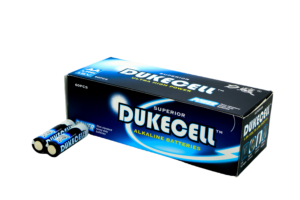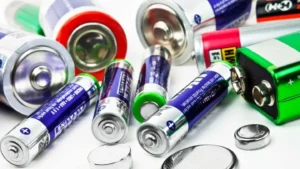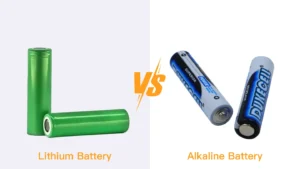Every year, billions of household batteries are manufactured, used, and often improperly disposed of—many of them ending up where they shouldn’t. In the United States alone, over 3 billion household batteries are sold annually, and millions end up in landfills, posing growing environmental and safety risks.
From single use and rechargeable devices like remote controls and kids’ toys to power tools, smartphones, and laptops, batteries power nearly every aspect of modern life. But once they’re used up, many people don’t realize that putting batteries in the trash can be dangerous—and in many cases, illegal.
These batteries contain heavy metals such as lithium, cadmium, nickel, and lead. When thrown out with regular waste, they can leak toxins into the soil and groundwater, or even catch fire in garbage trucks and waste facilities—especially lithium ion batteries.
So what’s the right way to deal with them? In this article, we’ll break down different battery types, what the laws say, and how to practice safe battery recycling at home or at work.
Different Battery Types, Different Risks

Not all batteries are created equal—but nearly all of them can pose serious risks if thrown in the trash. In fact, many common battery types are classified as household hazardous waste in several U.S. states, requiring special handling and disposal through certified recycling facilities.
Alkaline batteries (typically marked LR6 (AA), LR03 (AAA), LR14 (C)) are the most common single use batteries in household items like remote controls, clocks, and toys. Alkaline batteries contain zinc and manganese dioxide as active materials. While allowed in regular trash in some jurisdictions, they can still leach heavy metals over time, potentially contaminating soil and water.
Lithium ion batteries, used in smartphones, laptops, and power tools, are high-energy rechargeable batteries composed of materials like lithium cobalt oxide or lithium iron phosphate. When punctured, crushed, or overheated—as can happen in waste compactors—they can catch fire, explode, or release toxic gases, endangering waste handlers and the environment.
Nickel cadmium (Ni-Cd) batteries, commonly found in older electronics and cordless phones, contain cadmium, a highly toxic heavy metal that can persist in soil and water. Improper disposal may violate local environmental regulations.
Nickel-metal hydride (NiMH) batteries, a more modern and less toxic alternative, still contain rare earth elements that are resource-intensive to extract and environmentally damaging if landfilled.
Button cell batteries (such as CR2032, LR44) are found in watches, hearing aids, and toys. Many contain mercury, silver, or lithium, all of which are dangerous when they leach into groundwater or are accidentally ingested.
Even 9-volt batteries, often used in smoke alarms and toys, can catch fire if their terminals touch metal objects in the trash.
How to Properly Dispose of Different Battery Types?

Here’s how to responsibly dispose of the most common battery types:
Alkaline batteries (AA, AAA, C, D): These single use batteries, labeled as LR6, LR03, LR14, are allowed in household trash in some states, but battery recycling is strongly encouraged. Many retailers like Best Buy, Home Depot, and Lowe’s offer public drop-off bins, often in partnership with Call2Recycle.
Use the Call2Recycle locator to find the nearest drop-off site.Lithium ion batteries: Found in phones, laptops, and power tools, these rechargeable batteries must never be thrown in the trash or curbside recycling. They are considered high-risk due to fire and explosion potential. Tape the terminals, place them in a sealed plastic bag, and take them to certified recycling facilities or electronics stores with take-back programs.
This follows DOT guidelines for safe battery transport.Nickel cadmium (Ni-Cd) & Nickel-metal hydride (NiMH): These are also classified as hazardous waste in most jurisdictions. Used in older electronics and tools, they must be taken to local hazardous waste collection events or authorized recycling locations. Many communities host drop-off days throughout the year—check with your county’s solid waste authority.
Button cell batteries (e.g., CR2032, LR44): Found in watches, hearing aids, and toys, these compact batteries often contain mercury, silver, or lithium. Store them in a closed container until you can return them to electronics stores, jewelry shops, or designated battery recycling centers.
Lead-acid batteries: Used in cars, solar storage, and UPS systems, these are illegal to throw away in all 50 states. Most auto part stores accept them for free drop-off or offer an exchange credit when you purchase a new one.
For businesses or organizations managing large quantities of used batteries, it’s essential to work with licensed recycling partners who follow EPA and DOT compliance standards. Some providers also offer pickup logistics and certification.
Always check your local recycling authority or solid waste department website for up-to-date rules and available programs. When in doubt—don’t toss it, recycle it.
Laws and Regulations

Improperly disposing of batteries isn’t just unsafe—it’s often illegal. Around the world, countries and jurisdictions have developed strict environmental laws to address the risks of battery waste. These regulations vary widely, and non-compliance can result in civil fines, waste service denial, or environmental liability.
In the United States, the Environmental Protection Agency (EPA) classifies many battery types—including li ion batteries, nickel-cadmium, and lead-acid—as household hazardous waste under the Resource Conservation and Recovery Act (RCRA). This means they must be handled through approved recycling or hazardous waste channels.
Learn more from the EPA: Battery Recycling and Disposal Guidelines
Several states go further. California, Vermont, Minnesota, and New York prohibit all battery types from being discarded in the trash, regardless of chemistry or size. In these states, battery recycling is not optional—it’s enforced.
In Canada, battery disposal is regulated at the provincial level. Programs like Call2Recycle are federally supported and mandatory in provinces such as British Columbia, Ontario, and Quebec. Retailers are often required to offer free public collection points.
The European Union enforces the EU Battery Directive, which includes rules for manufacturer responsibility, mandatory labeling, recycling targets, and a complete ban on most batteries being landfilled. Non-compliance can result in import bans, product recalls, or regulatory penalties.
Official source: EU Battery Directive 2006/66/EC
Important for Regulated Regions
If you live or operate in California, Vermont, New York, or within the EU, local law requires you to recycle batteries through approved programs. Businesses managing battery systems or selling battery-powered products may also face reporting and product stewardship obligations.
In contrast, some U.S. states still allow alkaline battery disposal in household trash—but this is becoming increasingly discouraged as environmental standards evolve.
Bottom line: Battery types require different disposal methods—there’s no one-size-fits-all approach. Always check with your local environmental agency or recycling authority, especially if you’re operating in a regulated region. When in doubt—recycle it. Don’t trash it.
Batteries may be small, but their environmental impact is big. Whether you’re dealing with alkaline, lithium-ion, or rechargeable batteries, tossing them in the trash can lead to fires, toxic leaks, and even legal penalties. By understanding local laws and using proper recycling channels, you’re not just protecting the planet—you’re staying compliant.
Need help managing battery waste or sourcing compliant battery solutions?
Talk to the experts at Dukecell. We offer battery manufacturing, wholesale, and OEM services—along with the knowledge to help you power your products sustainably and safely.
Contact us today to get expert guidance and the right battery solution for your business.




